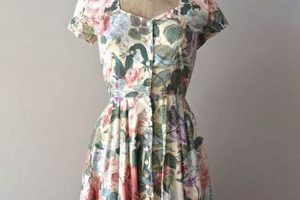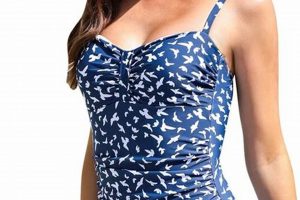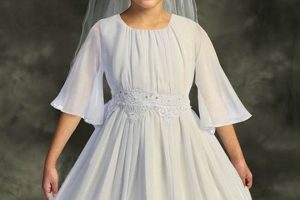Garments originating from the 1940s, characterized by distinct silhouettes, fabrics, and design elements reflective of the era, offer a tangible connection to a pivotal decade in history. These items often feature details such as strong shoulders, defined waists, and skirts typically falling just below the knee. An example would be a rayon crepe dress with a floral print and padded shoulders, showcasing the popular wartime austerity and resourcefulness through its design.
Acquiring and preserving these pieces provide insight into societal shifts, fashion trends, and material culture of the time. They represent a period of wartime restrictions, followed by a burgeoning optimism and a desire for feminine elegance. These articles of clothing serve as historical artifacts, offering valuable context to researchers, collectors, and individuals interested in understanding the past through tangible objects.
The following sections will delve into specific aspects of these garments, including the prevalent materials used, identifying characteristics to aid in authenticating pieces, and tips for proper care and preservation to ensure their longevity. A further exploration of prominent designers and their contributions to the decade’s aesthetic will also be provided.
Guidance on Acquiring and Maintaining Forties-Era Clothing
This section offers practical advice for those interested in owning and preserving clothing from the 1940s. Following these guidelines ensures the longevity and authenticity of these garments.
Tip 1: Verify Authenticity. Inspect the garment for period-accurate construction techniques, such as hand-stitched hems or the presence of metal zippers, commonly used during the decade. Fabric content, typically rayon, crepe, or cotton, should also align with wartime resource restrictions.
Tip 2: Assess Condition Carefully. Thoroughly examine the item for signs of damage, including stains, tears, and weakened seams. Small imperfections are common in older garments, but extensive damage may impact its structural integrity and value.
Tip 3: Understand Sizing Discrepancies. Be aware that sizing standards differed significantly in the 1940s. Consult size charts specific to the era and take accurate measurements before purchasing. Vintage sizes often run smaller than modern equivalents.
Tip 4: Store Properly. Protect garments from light, dust, and moisture by storing them in acid-free tissue paper and breathable garment bags. Avoid hanging delicate items; instead, store them flat to prevent stretching or distortion.
Tip 5: Clean with Caution. Dry cleaning is generally recommended for delicate fabrics, but consult a specialist experienced in handling vintage textiles. Hand-washing with mild detergent may be suitable for certain items, but always test a small, inconspicuous area first.
Tip 6: Repair Skillfully. Address minor damages promptly to prevent further deterioration. Seek out experienced tailors specializing in vintage clothing repair who understand the intricacies of period construction techniques. Utilize period-appropriate fabrics and notions for repairs whenever possible.
Adhering to these practices supports the preservation of these historical artifacts and allows them to be appreciated for generations to come. Careful attention to detail during acquisition, storage, and maintenance ensures their enduring beauty and historical value.
The subsequent portion of this discourse will address the economic and social influence that the demand for these garments has today.
1. Silhouette
The silhouette, or overall shape, constitutes a defining characteristic of garments from the 1940s. Wartime austerity measures and fabric rationing directly influenced the prevailing design aesthetic. Resource conservation resulted in narrower skirts, typically reaching just below the knee, to minimize fabric usage. Square shoulders, achieved through padding or strategic tailoring, created a strong, authoritative upper body line, reflective of women’s expanded roles in the workforce during the period. The emphasis on a defined waist, often achieved through belting or careful seaming, provided a sense of feminine form amidst the utilitarian constraints. Therefore, recognizing the distinctive shape of garments from the 1940s is crucial for authentication and appreciation. A dress with a full, sweeping skirt or excessive embellishments would likely indicate a later date of origin.
Consider the typical examples of work attire during the early half of the 1940s. Rayon dresses, popular due to their affordability and drape, frequently featured A-line skirts, padded shoulders, and three-quarter length sleeves. These garments prioritized practicality and mobility, reflecting the demands of wartime labor. Evening wear, while often more elaborate, still adhered to the defined waist and modest skirt length, albeit with richer fabrics and decorative details. Film stars, such as Katharine Hepburn or Lauren Bacall, further popularized this aesthetic, solidifying the “40s silhouette” as a symbol of both resilience and understated elegance. Their on-screen and off-screen wardrobes showcased the versatility of the style, demonstrating its suitability for both professional and social settings.
In summary, the silhouette of garments dating from the 1940s serves as a visual representation of the historical, economic, and social climate of the era. Its understated form, defined waist, and restrained skirt length stand in stark contrast to the more opulent styles of previous and subsequent decades. Understanding this signature shape aids in identifying genuine pieces, appreciating their historical significance, and recognizing the ingenuity and resourcefulness that characterized fashion design during a time of considerable constraint.
2. Fabric
The selection and utilization of materials are intrinsically linked to the garments produced during the 1940s. Fabric availability, government regulations, and economic conditions profoundly shaped the design and aesthetic of attire from this era. The following outlines key facets relating to the fabrics used in these vintage pieces.
- Rayon Crepe
Rayon, often marketed as artificial silk, became a predominant fabric due to its affordability and draping qualities. Rayon crepe, in particular, was favored for its textured surface and ability to hold its shape, making it suitable for dresses, blouses, and skirts. However, rayon production was sometimes prioritized for military applications, impacting civilian availability and resulting in the incorporation of other, less desirable, materials.
- Cotton
Cotton remained a staple fabric, but wartime restrictions often diverted higher quality cotton to military use. This led to the utilization of coarser cotton weaves for civilian clothing. Utility clothing schemes promoted the use of plain cotton fabrics in simple designs to conserve resources. Floral prints and small patterns were popular on cotton dresses, reflecting a desire for visual interest despite the limitations.
- Wool
Wool was a valuable resource, primarily used for military uniforms and outerwear. The scarcity of wool for civilian use resulted in higher prices and limited availability for dresses and other garments. When wool was used, it was often blended with other fibers to extend its usage and reduce costs. Strict regulations governed the wool industry to ensure adequate supplies for the war effort.
- Rationing and Substitution
Fabric rationing significantly impacted the production and availability of garments. The Utility Scheme in Britain, for example, aimed to streamline clothing production and reduce material consumption. This encouraged the use of simpler designs, fewer embellishments, and the substitution of materials. Leftover fabrics were often repurposed and recycled, leading to patchwork designs and creative adaptations.
The fabrics used in garments from the 1940s provide valuable insights into the material conditions and resource constraints of the era. Understanding the properties and limitations of rayon, cotton, and wool during this period enhances the appreciation of the ingenuity and resourcefulness displayed in the design and construction of these enduring pieces. The fabric itself serves as a historical marker, reflecting the economic and social realities of the time.
3. Details
The subtle yet distinct characteristics found in these garments, hold considerable significance in identifying authenticity and appreciating the aesthetic of the era. The details, ranging from closures and stitching to embellishments and lining, offer valuable clues about a garment’s origins, construction, and intended purpose. An absence or presence of specific attributes can fundamentally alter the authenticity of the garment.
Specifically, closures provide telling evidence. Metal zippers, frequently employed during this period, often bear markings specific to the manufacturer and year of production. Similarly, the presence of hand-stitched elements, such as hems or seams, is indicative of the time’s manufacturing practices. Fabric-covered buttons, often meticulously crafted, add to the overall elegance and reflect the attention to detail prevalent at the time. Linings, typically made of rayon or cotton, offer additional insights into the quality and construction of the garment. Their condition and type further contribute to assessing the historical accuracy of the piece. Consider the example of a garment purported to be from the 1940s which has a plastic zipper; this would be a clear indication that the piece is a later reproduction or alteration, therefore failing authenticity standards.
Embellishments, though often restrained due to wartime austerity, also offer crucial information. Simple embroidery, delicate lace trim, or strategically placed decorative buttons provided visual interest without excessive use of materials. The placement and style of these details speak volumes about the designer’s intent and the prevailing fashion trends. Understanding these details enables discerning collectors and enthusiasts to differentiate authentic garments from reproductions or later adaptations. Ultimately, scrutinizing these elements unlocks an appreciation for the craftsmanship and historical context embedded within garments dating from the 1940s.
4. Authenticity
Determining the authenticity of garments from the 1940s involves a detailed assessment of construction techniques, materials, and design elements characteristic of the period. A garment’s purported origin is directly linked to its construction, the types of fabrics employed, and the presence or absence of specific details. Examining these elements facilitates the discernment of genuine articles from later reproductions or adaptations. For example, a dress claimed to originate from the 1940s yet featuring a polyester lining would immediately raise concerns, as polyester was not widely available until after the decade. Similarly, construction techniques, such as serged seams, are indicative of more modern manufacturing processes, absent in the examined era.
The significance of authenticity extends beyond mere historical accuracy; it directly impacts the value, preservation, and understanding of these textiles. Authentic items offer insight into wartime resource restrictions, societal norms, and technological advancements of the period. The presence of original labels, handwritten alterations, or documented provenance further strengthens the claim of authenticity, providing a richer context. The absence of such features does not automatically invalidate a garment’s claim to the period, but increases the need for meticulous examination of construction techniques, materials, and design elements.
Accurate dating and authentication of 1940s garments is thus crucial for collectors, historians, and those involved in the preservation of textiles. Challenges exist due to the scarcity of documented information for mass-produced items, reliance on expert knowledge, and the presence of later alterations. However, understanding the markers of authenticity enables a greater appreciation of the historical significance and artistic merit. This knowledge ultimately contributes to the preservation of these pieces and their stories for future generations.
5. Condition
The physical state of garments originating from the 1940s significantly impacts their value, wearability, and historical significance. Assessing condition necessitates a meticulous examination, considering factors such as fabric integrity, seam strength, and presence of damage or alterations.
- Fabric Degradation
Textiles from this era, often composed of rayon, crepe, or cotton blends, are susceptible to degradation over time. Exposure to light, moisture, and improper storage can weaken fibers, leading to tears, discoloration, or a loss of structural integrity. For instance, rayon, a common fabric, is particularly vulnerable to moisture damage, resulting in irreversible staining or disintegration. The degree of fabric degradation directly influences the garment’s ability to withstand wear and the feasibility of restoration efforts.
- Seam Stress and Integrity
Garments from the 1940s typically exhibit hand-stitched or machine-sewn seams. Over time, these seams may experience stress due to wear, improper storage, or alterations. Weakened seams can lead to seam slippage, tearing, or complete separation. For example, shoulder seams, bearing significant weight and stress, are prone to failure. The integrity of the seams directly impacts the garment’s overall structure and fit, affecting its wearability and aesthetic appeal.
- Staining and Discoloration
The presence of stains or discoloration can significantly diminish the value and aesthetic appeal of garments. Stains from perspiration, food, or environmental factors are common in vintage textiles. Discoloration, resulting from light exposure or improper cleaning, can alter the original color of the fabric. Severe staining or discoloration may prove irreversible, affecting the garment’s overall condition and desirability.
- Alterations and Repairs
Previous alterations or repairs can impact the originality and value. While alterations were common to accommodate changing body shapes or style preferences, they may compromise the garment’s original design and construction. Similarly, repairs, if not executed with period-appropriate techniques and materials, can detract from the item’s authenticity and aesthetic appeal. Documentation of alterations and repairs, if available, can provide context and insight into the garment’s history.
The condition of garments originating from the 1940s constitutes a critical factor in determining their preservation, restoration potential, and overall value. Thorough assessment, considering fabric degradation, seam integrity, staining, and alterations, is crucial for informed decision-making regarding acquisition, conservation, and display. Proper evaluation ensures the longevity and appreciation of these historical textiles.
Frequently Asked Questions
This section addresses prevalent inquiries regarding garments from the 1940s, providing clarity and factual information for collectors, researchers, and enthusiasts.
Question 1: How can one differentiate between an authentic garment originating from the 1940s and a modern reproduction?
Authentic examples display construction techniques, closures, and fabric types consistent with the period. Metal zippers, hand-finished seams, and fabrics like rayon crepe are common indicators. Modern reproductions often utilize synthetic fabrics, plastic zippers, and serged seams, which were not prevalent during the decade.
Question 2: What is the appropriate method for cleaning and preserving clothing items from this era?
Professional dry cleaning by a specialist experienced in handling vintage textiles is generally recommended. Hand-washing may be suitable for certain sturdy cotton items, employing a mild detergent. Proper storage in acid-free tissue paper and breathable garment bags is crucial to prevent damage from light, dust, and moisture.
Question 3: How did wartime rationing affect the styles and materials used in garments produced during the 1940s?
Rationing led to simpler designs, reduced fabric consumption, and the utilization of alternative materials. Skirt lengths were shorter, embellishments were minimal, and fabrics such as rayon and cotton became more prevalent due to their availability. Utility schemes aimed to streamline clothing production and conserve resources.
Question 4: What are the typical sizing considerations when purchasing vintage garments from this era?
Sizing standards differed significantly in the 1940s. Consulting size charts specific to the era and taking accurate measurements is essential. Vintage sizes often run smaller than modern equivalents. It is advisable to compare measurements to ensure a proper fit.
Question 5: What factors contribute to the value and collectibility of an item of clothing dating to the 1940s?
Authenticity, condition, rarity, historical significance, and provenance influence the value and collectibility. Garments with original labels, minimal damage, and documented history command higher prices. Items associated with notable individuals or events also hold greater value.
Question 6: What are some common issues encountered when storing and displaying garments from this era?
Exposure to light, dust, and moisture can cause fading, fabric degradation, and mold growth. Improper hanging can distort the garment’s shape, while acidic storage materials can damage fibers. Proper environmental control and appropriate storage methods are crucial for preservation.
In conclusion, understanding the intricacies of construction, materials, and preservation techniques is vital for appreciating and maintaining the historical integrity of garments originating from the 1940s.
The subsequent section will explore prominent designers and their contributions.
Conclusion
This exposition detailed the multifaceted nature of garments from the 1940s, encompassing aspects from material composition and construction techniques to authentication methods and preservation practices. The discussion emphasized the influence of wartime austerity, technological advancements, and evolving societal norms on the garments produced during this pivotal decade. A thorough understanding of these factors is paramount for collectors, historians, and anyone seeking to appreciate the enduring legacy of this era in fashion.
These garments serve as tangible links to the past, providing insights into a transformative period in history. Continued research, responsible preservation efforts, and a commitment to sharing knowledge are crucial to ensuring that these artifacts remain accessible for future generations, fostering a deeper appreciation for their historical significance and cultural value.







